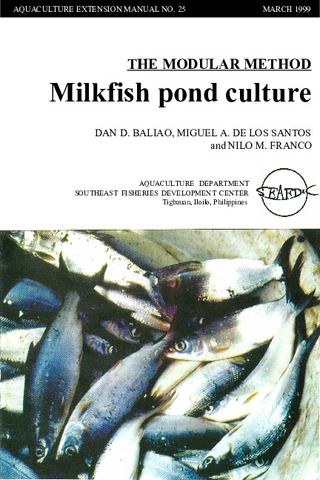Viability of milkfish eggs and larvae after simulated and actual transport
- Global styles
- MLA
- Vancouver
- Elsevier - Harvard
- APA
- Help

View/
Date
1996Page views
4,801ASFA keyword
AGROVOC keyword
Taxonomic term
Metadata
Show full item record
Share
Abstract
The viability of milkfish eggs and larvae after simulated and actual transport was investigated. Naturally-spawned milkfish eggs were collected and subjected to simulated or actual transport at early cleavage stage (stage 1), blastula (stage 2), gastrula (stage 3), "eyed" (stage 4), or newly-hatched larvae (stage 5). Replicate samples in aerated plastic jars served as controls. Mean hatching and survival rates and the percentage of newly-hatched larvae were significantly affected by the modes of transport and by the stage of embryonic development at transport. Eggs transported at the 'eyed' stage had higher viability compared to those transported at cleavage, blastula, or gastrula stages. There was no significant difference in the mean survival rate of the larvae after 26 days of rearing. However, the percentage of 45 day old larvae with apparent morphological abnormalities was lower in groups transported at stages 4 and 5. These observations indicate that milkfish eggs should be handled and transported during the late embryonic stages to minimize mortalities and the incidence of abnormalities in larvae.
Suggested Citation
Toledo, J. D., Doi, M., & Duray, M. (1996). Viability of milkfish eggs and larvae after simulated and actual transport. In D. MacKinlay & M. Eldridge (Eds.), The Fish Egg: Its Biology and Culture Symposium Proceedings. International Congress on the Biology of Fishes, San Francisco State University July 14-18, 1996 (pp. 51–58). Physiology Section, American Fisheries Society.
Type
Conference paperCollections
- Conference Proceedings [299]
Related items
Showing items related by title, author, creator and subject.
-
Series: Aquaculture extension manual; No. 25
The modular method: Milkfish pond culture
Baliao, Dan D.; de los Santos, Miguel A.; Franco, Nilo M. (Aquaculture Department, Southeast Asian Fisheries Development Center, 1999)The modular method of milkfish culture (Chanos chanos) described in the manual is an improvement over the traditional extensive method. The manual is intended for the use of fish farmers and aquaculturists, extensionists, ... -
Evaluation of organic and inorganic fertilizers in brackishwater milkfish ponds
Bombeo-Tuburan, Isidra; Agbayani, Renato F.; Subosa, Precilla F. (Elsevier, 1989)The study was conducted in twelve 144-m2 ponds to evaluate the effect of different organic and inorganic fertilizers on the growth, survival, gross production, and profitability of marketable milkfish. The ... -
Milkfish breeding and hatchery technology at SEAFDEC/AQD
Unknown author (Aquaculture Department, Southeast Asian Fisheries Development Center, 1999)Describes the techniques already adopted by the private sector: broodstock management, broodstock diet, commercial fry production, live transport, and larval diet. A list of AQD research publications on milkfish is included.





